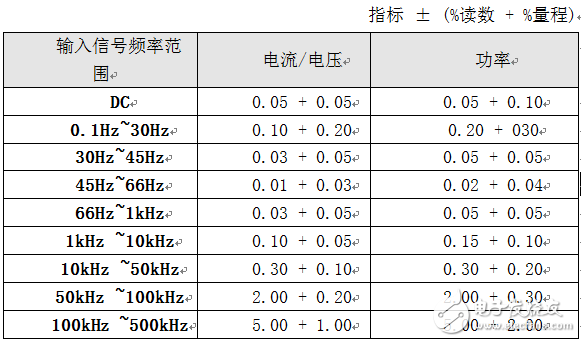In the measurement industry, the range is a familiar term. The choice of range should first protect the instrument from reducing its reliability or being damaged during the test; secondly, reduce the measurement error and improve the credibility of the test results. When testing, it is well known that you choose a range that is larger than and closest to the measured signal value.
For example, to test the 220VAC mains signal, there is a 300V multimeter and a 1000V multimeter. There is no doubt that you must choose a 300V multimeter.
You may know that this choice can reduce the measurement error, but do you know the principle?
This is because selecting a range that is greater than and closest to the measured signal value can reduce unnecessary full-scale error.
What is the full scale error?
In the test instrument industry, accuracy is one of the most important indicators of the instrument. Accuracy is the error range of the instrument's measured values. The error type is divided into "error proportional to the measured value" and "fixed error independent of the measured value". The accuracy index of the general instrument is the sum of the two errors. For example, the power analyzer PA6000 has a power accuracy of 0.02% reading + 0.04% of the range in the working frequency range (45 Hz to 66 Hz), as shown in Table 1. Among them, the reading error is an error proportional to the measured value, and the range error is a fixed error, that is, a full-scale error.
Table 1 PA6000 measurement accuracy

Assume that the power analyzer PA6000 is selected to test the 220VAC mains signal, and its voltage range is shown in Table 2.
Table 2 Voltage measurement range 
When testing with a 300V range,
Full scale error
0.04% range=0.04%*300=0.12V
Absolute error is
0.02% reading + 0.04% range = 0.02% * 220 + 0.04% * 300 = 0.164V
Relative error is
0.164/220*100%=0.0745%
When testing with the 1000V range,
Full scale error
0.04% range=0.04%*1000=0.4V
Absolute error
0.02% reading + 0.04% range = 0.02% * 220 + 0.04% * 1000 = 0.444V
Relative error
0.444/220*100%=0.2018%
From the above results, it can be clearly seen that by selecting the 300V range close to the measured value, the full-scale error can be reduced by 0.28V (0.4-0.12=0.28V), and the relative error can be reduced by 0.1273% (0.2018%-0.0745%=0.1273%).
Therefore, in order to reduce unnecessary full-scale error and improve test reliability, it is necessary to select a range larger than and closest to the measured signal value.
2 In 1 Laptop
Do you know the difference of Yoga Laptop and 2 in 1 laptop? No. 1 is yoga notebook with 360 flip rotating absolutely; No.2 is laptop yoga slim is just like normal Education Laptop-connecting screen with keyboard, but 2 in 1 laptop tablet with pen is separately, you can use the monitor part as a window tablet. In one word, every intel yoga laptop have all the features and function of tablet 2 in 1 laptop except separated screen and keyboard. From the cost, windows yoga laptop is much higher than 2 in 1 type., cause usually former with more complicated craft and quality.
What other products you mainly produce? It`s education laptop, Gaming Laptop, engineering laptop, Android Tablet, Mini PC and All In One PC. You can see more than 5 different designs on each series, believe always have right one meet your special application or your clients demands. Therefore, what you need to do is just to get all the requirement details from your clients, then share the complete information with us, then we can provide the most suitable situation.
Of course, you can also call or email or send inquiry of what you need, thus can get value information much quickly.
2 In 1 Laptop,2 In 1 Laptop Sale,2 In 1 Laptop Tablet With Pen,Tablet 2 In 1 Laptop,2 In 1 Laptop Deals
Henan Shuyi Electronics Co., Ltd. , https://www.shuyicustomtablet.com